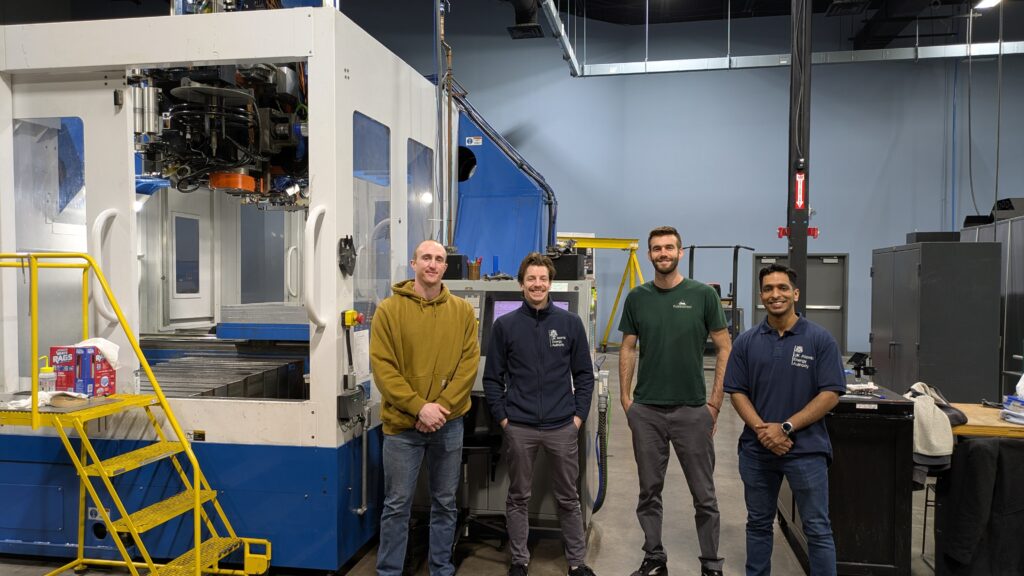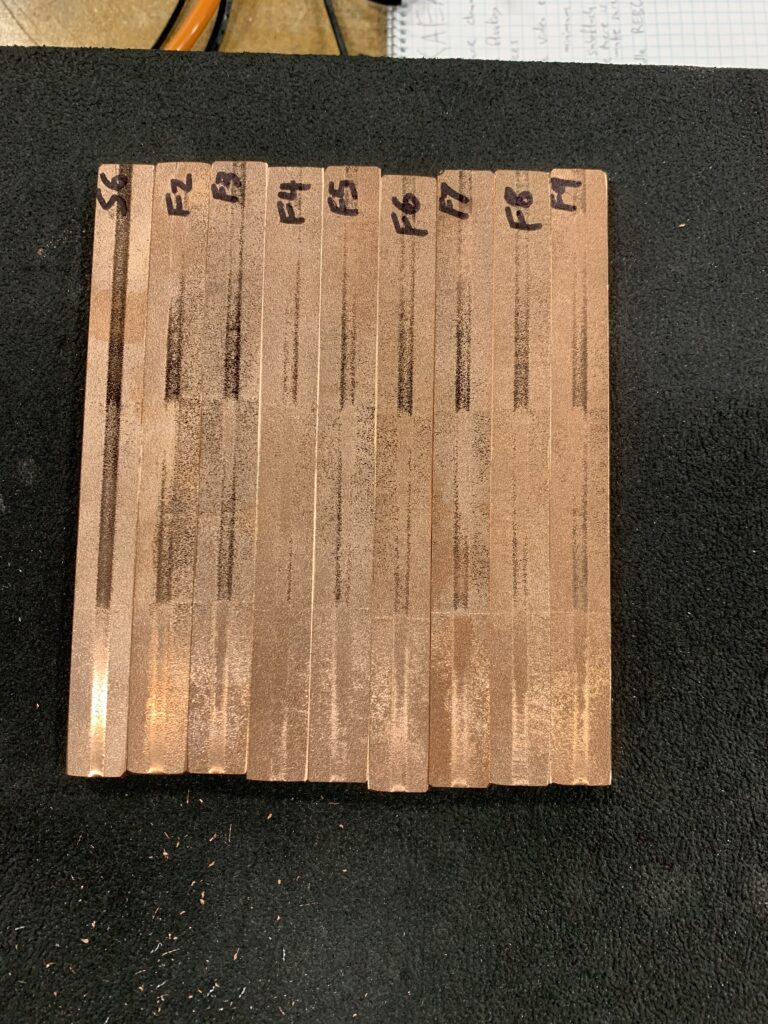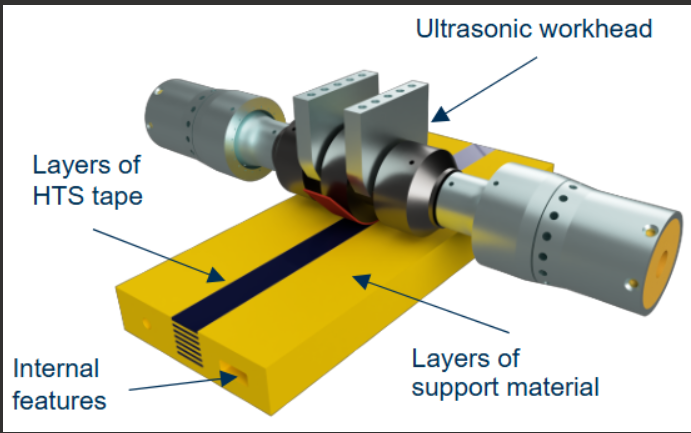Advancing High Temperature Superconducting (HTS) Integration via Ultrasonic Additive Manufacture (UAM)
UKAEA and Fabrisonic advanced ultrasonic additive manufacturing to join superconducting tapes, paving the way for compact, high-field fusion magnets.

Overview

The UK Atomic Energy Authority (UKAEA), in collaboration with US-based partner Fabrisonic, has successfully completed a second phase of testing in a pioneering innovation project. This initiative aims to develop a novel Ultrasonic Additive Manufacture (UAM) process for joining high-temperature superconducting (HTS) tapes – based on rare-earth barium copper oxide (REBCO) to support future fusion energy systems.
Background and challenge
REBCO (Rare-Earth Barium Copper Oxide) coated conductor tapes offer high critical current densities and strong magnetic field tolerance – key advantages for enabling compact, high-field magnet systems in fusion energy devices. However, their brittle ceramic nature makes them difficult to handle, process, and join at scale using conventional techniques.
The challenge was to develop a bonding method that is:
- Low-temperature – to prevent thermal degradation of the superconducting layer.
- Automated and repeatable – to suit industrial-scale production.
- Scalable and flexible – capable of embedding tapes into various metallic substrates and geometries.
- Compatible with multi-material architectures – enabling complex structural integration.
Project objectives
- Validate ultrasonic additive manufacturing as a viable joining method for REBCO tapes.
- Identify UAM process parameters that preserve the superconducting properties of HTS materials.
- Generate scalable, repeatable joining processes suitable for future fusion machines.
- Build UK capability through knowledge and innovative machines for manufacture of fusion components.
Collaborative approach
UKAEA partnered with Fabrisonic LLC, a US spin-out from EWI, whose hybrid UAM system combines additive layer-by-layer metal deposition with ultrasonic welding via a CNC-controlled sonotrode. The process enables solid-state bonding of similar or dissimilar materials at low temperatures; therefore, exploratory trials were conducted to see if the method could work on HTS tapes.
Electrical performance validation was supported by the Superconductivity Group at Ohio State University (OSU), which performed critical current and n-value testing of joined samples under cryogenic conditions.

Experimental progress
Phase 1
Initial trials explored a wide range of UAM process parameters. While some REBCO tapes showed degradation in electrical tests, microscopy confirmed mechanical integrity in others. The complexity of the process variables and their interdependencies – sonotrode speed, downforce, amplitude, and tape tension – made root cause analysis difficult.

Phase 2a
To reduce uncertainty, the team isolated variables and focused on ultrasonic spot welds of REBCO to copper. Peel tests were conducted to define bonding thresholds, enabling rapid, cost-effective iteration. Samples were then electrically tested at OSU in a liquid nitrogen environment, identifying the range of forces that preserved superconducting performance and sufficient bonding.
Phase 2b
Learnings from Phase 2a informed a more refined experimental design using a statistical Design of Experiment (DoE) approach. New sample geometries were introduced to isolate UAM-induced effects and eliminate external sources of damage. The goal was to reintroduce controlled complexity and optimise parameters such as UAM sonotrode rotation speed, amplitude, and downforce.
Electrical testing of Phase 2b samples under a liquid nitrogen environment is currently underway, with statistical analysis to follow using Taguchi methods to identify optimal processing windows.
Achievements
- Successful HTS bonding: Confirmed that UAM can preserve superconductivity across defined force ranges.
- Process understanding: Established a clear methodology for parameter exploration using peel tests, spot welding, and DoE techniques.
- International collaboration: Strengthened partnerships with Fabrisonic and OSU through in-person engineering trials and mutual knowledge sharing.
- Platform for scale-up: Laid the groundwork for future trials to prove repeatability, scalability, and industrial integration.
This is an exciting innovation project! Collaborative, hands-on engineering with international teams has been crucial in shaping a solution. I look forward to the future of UAM of HTS.
— Davidson Sabu, Lead Fusion Technologist, UKAEA
It was a pleasure hosting the UKAEA team at our facility. Their creativity and engineering insight made for a truly collaborative experience. We had many productive conversations exploring how UAM can be used to embed HTS tapes, and I’m excited to continue working together to make this innovation a reality.
— Jason Riley, CEO, Fabrisonic
Impact and next steps
This project is a key example of UKAEA’s innovation-led approach to solving practical engineering challenges for future fusion energy systems. The ability to embed HTS tapes in structural copper using scalable, low-temperature methods could unlock new design possibilities for compact high-field magnets, supporting STEP, the private fusion industry and other fusion prototype machine development.

Wider applications
While this project focuses on fusion energy, REBCO-based HTS systems have the potential to transform multiple sectors. Potential applications include:
- Magnetic confinement of plasma in fusion power plants
- Electrical transport (including road, rail, and air)
- Medical and scientific research (including MRI, particle physics, and spectroscopy)
- High power electrical systems (including transmission, storage, and protection)
The upcoming Phase 3 will validate long-term repeatability and build evidence for industrial adoption, whilst conducting proactive market engagement to better understand the future UK customer base for UAM technology.
Contact
To learn more about this project or to engage with UKAEA’s HTS or additive manufacturing research, click below to get in touch.